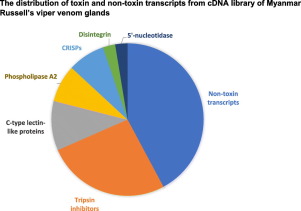当前位置:
X-MOL 学术
›
Comp. Biochem. Physiol. C Toxicol. Pharmacol.
›
论文详情
Our official English website, www.x-mol.net, welcomes your feedback! (Note: you will need to create a separate account there.)
Complementary DNA library of Myanmar Russell's viper (Daboia russelii siamensis) venom gland.
Comparative Biochemistry and Physiology C: Toxicology & Pharmacology ( IF 3.9 ) Pub Date : 2019-10-23 , DOI: 10.1016/j.cbpc.2019.108634 Khin Than Yee 1 , Ponlapat Rojnuckarin 2
Comparative Biochemistry and Physiology C: Toxicology & Pharmacology ( IF 3.9 ) Pub Date : 2019-10-23 , DOI: 10.1016/j.cbpc.2019.108634 Khin Than Yee 1 , Ponlapat Rojnuckarin 2
Affiliation

|
Geographical variations of snake venoms of the same species are well-known. Exploring the components of venom from each region will give insights in its distinctive toxicities. Venom gland cDNA library of Russell's viper (RV) from Myanmar (Daboia russelii siamensis) was constructed to create a catalog of expressed sequences tags (ESTs) and to compare with sequences from RV of other countries. The cDNA library of venom gland was generated by using CloneMiner™ II cDNA Library Construction Kit. Clones were subjected to Sanger sequencing and analyses by bioinformatics tools. From 251 isolated clones, 38 ESTs were assembled into 6 clusters and 21 singlets. Toxin sequences contributed to 57.9% of all transcripts and Kunitz-type serine protease inhibitors are most abundant (45.5% of toxin transcripts). The Myanmar RV phospholipase A2 (PLA2) showed 98% and 74% identity to D. r. russelii PLA2 from India (DrK-bI) and PLA2 of D. r. siamensis from Thailand as well as Taiwan, respectively. The cysteine-rich secretory protein (CRISP) homologs from Myanmar RV were first identified here showing homology to CRISP from Taiwan RV and European vipers with 98% and 90% identity, respectively. The RV 5' nucleotidase was also first cloned. In summary, Myanmar RV showed a unique gene expression pattern and sequences. Large scale analysis by next-generation sequencing is warranted.
更新日期:2019-10-23



























 京公网安备 11010802027423号
京公网安备 11010802027423号